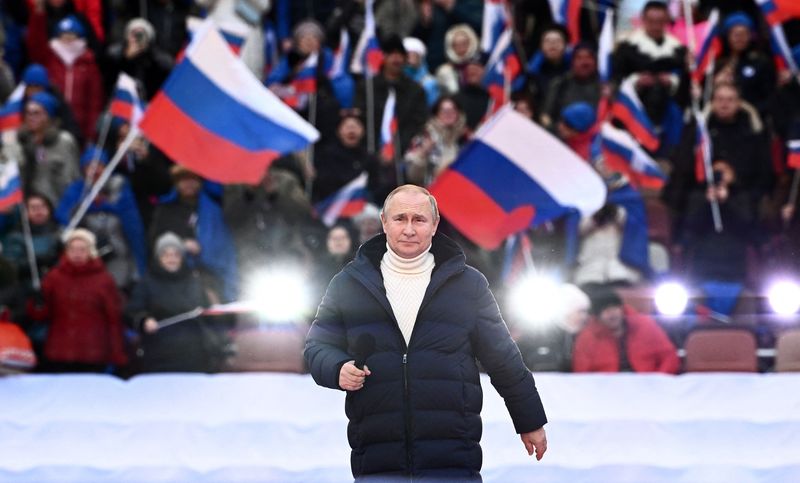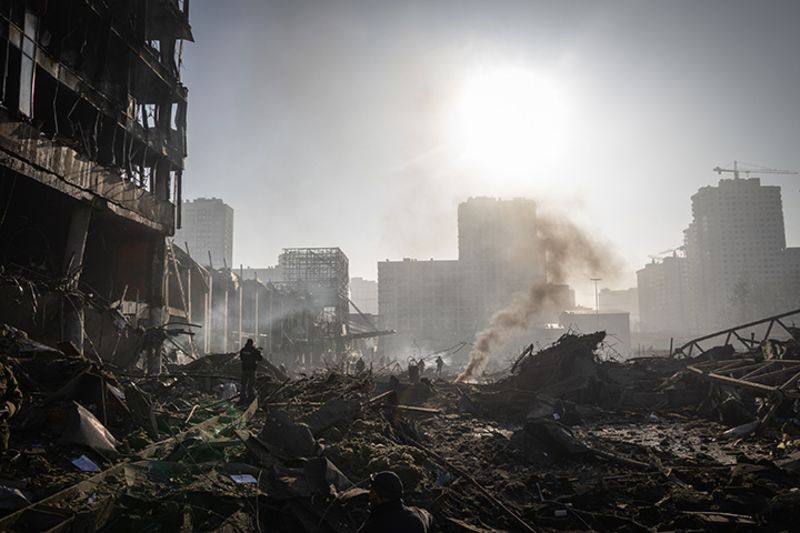Two days after President Vladimir Putin sent his armed forces into Ukraine, Russian state news agency RIA Novosti published an article that assumed imminent victory. It celebrated “a new era,” marked by the end of Western domination, the severing of bonds between the U.S. and continental Europe and the return of Russia to its rightful “space and place” in the world.
As the war rages on, heralding the arrival of a single Russian World to unite Ukraine with Belarus and Russia looks at best premature. RIA Novosti soon took the article down. But the author was right about one thing: Putin’s decision to invade does appear to be changing the international order, just not necessarily in the way he planned.
From Berlin to London and Baltic capitals like Tallinn, the metrics of defending Europe have been torn up. A large scale war is no longer unthinkable and nations are reconsidering what they spend, what they buy, and how they would need to fight.

Rather than split from the U.S., NATO’s European members have cleaved to it. Rather than shrink to its pre-expansion size of the 1990s — as Putin demanded before his invasion — the alliance is positioning more personnel on its frontiers. NATO has sent about an additional 3,000 troops to its eastern flank, as well as helicopters, tanks and fighter jets, to deter any potential Kremlin decision to expand the battlefield.
“No matter how this war turns out — and as cynical as it sounds now — historians will say that Putin’s attack on Ukraine gave Europe the time it needed to recover so it could confront Russia and, further down the road, China,” said General Richard Barrons, a former commander of the U.K.’s Joint Forces Command. “Ukraine is paying a high price to buy us time.”
The big question for Europe will be what it does with that time. Germany’s commitment to spend an additional 100 billion euros ($110 billion) is only the most obvious example of stepping up militarily, one that has implications for the balance of power within Europe, as well as with Russia.

Others are upping their defense budgets, too, including the three tiny Baltic States, which have long rung the alarm bell over Putin. They are also asking NATO for permanent bases, as well as long-range anti-aircraft systems, even if it’s less clear they’ll get them.
None of that suggests a return to stability in Europe, but a recognition of its loss. Putin’s invasion of Ukraine “is a post-imperial, post-colonial land grab,” Fiona Hill, the former senior director for European and Russian affairs on the U.S. National Security Council, said last week at the Metropolitan State University of Denver. “If we let this happen, we’re setting a precedent for the future.”
Those extra billions can be spent effectively, or not. As the initial shock of the war and inspirational impact of the Ukrainian resistance inevitably fades, NATO’s unity and determination may do so too.
From Opinion: Putin and Xi Exposed the Great Illusion of Capitalism
Putin may yet be able to achieve some of his goals and there’s every indication he may choose isolation for Russia — and permanent instability for Ukraine and Europe — over acknowledging his mistake. Defeat could call into question his political survival.

“It is still a race,” said David Shlapak, senior defense researcher at the Rand Corporation, a U.S. think tank. “It is a race where they have motivated us to start running, but it is still a competition that neither side is pre-ordained to win or lose. There are a lot of cards that still need to be played on the NATO side to figure that out.”
Shlapak was responsible for a war game Rand conducted after Russia’s annexation of Crimea in 2014, to predict what would happen if Russia were to invade the three Baltic states. The results made news headlines because they were sobering: Russian forces would reach the Estonian, Latvian and Lithuanian capitals in 60 hours.
In a “fait accompli,” they would also close the so-called Suwalki Gap — a land corridor that runs from the border of Belarus to the Russian enclave of Kaliningrad — before other, larger NATO allies had time to respond.
It’s natural to be skeptical of such a lightning attack after the events in Ukraine over the past three weeks, but also too early to say what the war will change among the assumptions fed into Rand’s war game, said Shlapak. Russia’s leaders and commanders would surely go about an attack on NATO very differently.
Still, the Russian military has been mauled and its stock of precision guided missiles depleted. Barring a catastrophic escalation of the current conflict, that should make a Russian war of choice with NATO less likely in future than it was before Feb. 24, according to Michael Mazarr, a former special assistant to the U.S. Chairman of the Joint Chiefs of Staff.

For sure, in three or five years, Putin’s generals will have learned lessons, regrouped and rearmed, he said, but they’ll be hobbled by sanctions that limit access to technologies and finance. On Tuesday, U.S. National Security Advisor Jake Sullivan told reporters that allies would seek to tighten and expand sanctions on Russia when they meet later this week.
That, said Mazarr, is where the more worrying change to Europe’s security order comes in. Stability between great powers depends on reaching some mutual agreement to maintain the status quo, he said. That was achieved even with the Soviet Union after the 1960s, but never with Putin’s Russia. And, whatever the wisdom of NATO’s post-Cold War expansion, such a deal may now be impossible.
After Ukraine, “there is no treating the kind of regime that’s in the Kremlin as a geopolitical partner,” said Mazarr. “We are now locked into an indefinite confrontation with an increasingly humiliated, hyper-nationalistic and dangerous great power in decline.”
Concern in Washington has focused on whether China decides to help Russia evade sanctions and reequip, a move that would invite further U.S. sanctions and accelerate the world’s redivision into economic and geopolitical blocs. China has denied Moscow even asked for help and so far there are few concrete signs that it will.
In front-line NATO states, defense officials are less focused on Russian military snafus in Ukraine and more on the evidence that Putin can act on false assumptions.
“Russia wants to restore this Soviet type bloc of states in this part of the world,” said Brigadier General Riho Ühtegi, commander of the Estonian Defense League, a volunteer reserve of 19,000 adults and 6,000 cadets. “Maybe we are not next – there is Moldova and still Georgia, there’s a frozen conflict between Azerbaijan and Armenia, and there’s Kazakhstan — there are many places Russia has to do something. But we have to be ready.”
Ühtegi said he’s received about 1,000 applications to join his force since the invasion of Ukraine began, half from women. He’s also planning to buy more of the anti-tank weapons and shoulder fired anti-aircraft missiles that the Ukrainians have deployed to such effect.

Most of all, though, Ühtegi is convinced that events have proved wrong Rand’s assumptions about how such a war would in fact play out in the Baltics. No doubt Russian forces would move quickly to the capitals, but the war would — as in Ukraine — be fought behind Russian lines and in cities. It would not be a done deal. “If NATO forces took a while to come they would not be coming to occupied territory,” said Ühtegi. “They would be coming to a war zone.”
Source: Bloomberg


COMMENTS